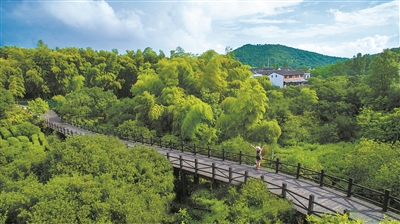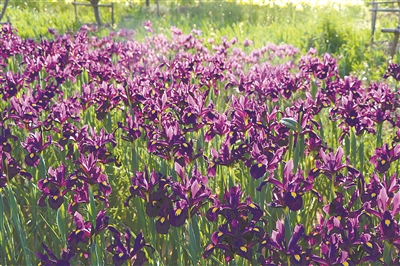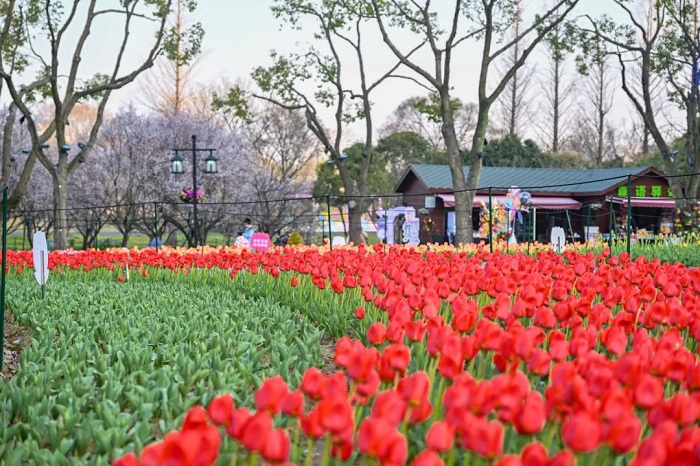
高度城镇化地区非建设用地转用的时空特征
编号
lyqk010122


中文标题
高度城镇化地区非建设用地转用的时空特征


作者单位
苏州科技大学建筑与城市规划学院 江苏苏州 215011


期刊名称
中国城市林业


年份
2023


卷号
21


期号
1


栏目名称
研究论文


中文摘要
高强度人类活动深刻改变了山水林田湖草等非建设用地的规模结构和布局形态,其转用过程和规律特征仍有待揭示。文章利用多时相遥感影像数据,借助土地利用转移矩阵和地学信息图谱分析方法,系统探究苏州1995-2020年非建设用地转用的时空特征,以期为山水林田湖草等非建设用地的保护和高效利用提供参考。结果表明:1)非建设用地以耕地为主体持续减少,水域面积略有增加;2)非建设用地转用呈现为初始平缓、快速缩减和稳定恢复3个阶段;3)非建设用地转用由城镇向乡村地带缓慢过渡,耕地主要流向城镇用地,水域和林地则多流向农村居民点;4)非建设用地转用为建设用地整体呈现一环三线多点模式,沪苏锡通道沿线及太湖东部、长江南岸是其转用的热点区域。


基金项目
国家自然科学基金(51908392);2020年江苏省研究生实践创新计划(SJCX20_1131)


英文标题
Temporal and Spatial Characteristics of Non-construction Land Conversion in Highly Urbanized Areas


作者英文名
Yu Xi, Shao Dawei, Wu Dianming


单位英文名
School of Architecture and Urban Planning, Suzhou University of Science and Technology, Suzhou 215011, Jiangsu, China


英文摘要
High-intensity human activities have profoundly changed the scale, structure and layout of non-construction land such as mountains, rivers, forests, fields, lakes and grassland, and the process and regular characteristics of its conversion remain to be revealed. Using multi-temporal remote sensing image data, the paper takes land-use transfer matrix and geo-information spectrum method to explore the temporal and spatial characteristics of non-construction land conversion in Suzhou from 1995 to 2020, in order to contribute to the protection and high-efficiency utilization of non-construction land. The results show that:1) The non-construction land, dominated by cultivated land, has continued to decrease, while the water body increased slightly in area; 2) The conversion of non-construction land presents three stages of initial stable increase, rapid reduction and stable recovery; 3) The conversion of non-construction land has slowly transitioned from urban areas to rural areas, and cultivated land has been converted mainly to urban land, while water bodies and forest land converted to rural residential areas; and 4) The conversion of non-construction land to construction land generally presents a one ring, three lines and multiple points model, while the areas along the Shanghai-Suzhou-Wuxi corridor, the east of Taihu Lake and the south bank of the Yangtze River are the hot spots for the conversion.


英文关键词
non-construction land;transfer matrix;geo-informatic spectrum;temporal and spatial differentiation;Suzhou


起始页码
87


截止页码
94


投稿时间
2021/6/11


作者简介
喻茜(1997-),女,硕士生,研究方向为现代园林与景观设计。E-mail:18951322880@163.com


通讯作者介绍
吴殿鸣(1984-),女,讲师,博士,研究方向为城乡绿地生态空间效能。E-mail:wudmsz@163.com


E-mail
wudmsz@163.com


DOI
10.12169/zgcsly.2021.06.11.0002


参考文献
[1] 成金华,尤喆.山水林田湖草是生命共同体原则的科学内涵与实践路径[J].中国人口·资源与环境,2019,29(2):1-6.
[2] 刘纪远,刘文超,匡文慧,等.基于主体功能区规划的中国城乡建设用地扩张时空特征遥感分析[J].地理学报,2016,71(3):355-369.
[3] LIU Y Q,SONG W,DENG X Z.Understanding the spatiotemporal variation of urban land expansion in oasis cities by integrating remote sensing and multi-dimensional DPSIR-based indicators[J].Ecological Indicators,2019,96:23-37.
[4] 王晓峰,傅伯杰,苏常红,等.西安市城乡建设用地时空扩展及驱动因素[J].生态学报,2015,35(21):7139-7149.
[5] DU J,XIANG X Y,ZHAO B Y,et al.Impact of urban expansion on land surface temperature in Fuzhou,China using Landsat imagery[J].Sustainable Cities and Society,2020,61:102346.
[6] 屈宇宏,孙帅,陈银蓉.中国城市建设用地扩张趋势模拟及抑制策略[J].资源科学,2014,36(1):1-7.
[7] 张永刚.浅议非城市建设用地的城市规划管理问题:以深圳市为例[J].规划师,1999,15(2):74-76.
[8] 喻锋,李晓波,张丽君,等.中国生态用地研究:内涵、分类与时空格局[J].生态学报,2015,35(14):4931-4943.
[9] 张梦贤,周勇,曹隽隽,等.2000-2015年武汉市生态用地时空变化分析[J].中国农业资源与区划,2021,42(1):168-177.
[10] 程遥,赵民.非城市建设用地的概念辨析及其规划控制策略[J].城市规划,2011,35(10):9-17,85.
[11] 金云峰,王俊祺,吴钰宾,等.基于土地利用的法国风景规划及体系研究[J].中国城市林业,2019,17(2):54-59.
[12] 刘颂,杨莹.生态系统服务供需平衡视角下的城市绿地系统规划策略探讨[J].中国城市林业,2018,16(2):1-4.
[13] 赵晓丽,张增祥,汪潇,等.中国近30a耕地变化时空特征及其主要原因分析[J].农业工程学报,2014,30(3):1-11.
[14] GONG Y L,LI J T,LI Y X.Spatiotemporal characteristics and driving mechanisms of arable land in the Beijing-Tianjin-Hebei region during 1990-2015[J].Socio-Economic Planning Sciences,2020,70:100720.
[15] 陈颐,林毅伟,林丽丽,等.基于Markov和Logistic模型的莆田市土地利用变化及林地转出空间模拟[J].中国农业大学学报,2017,22(2):87-97.
[16] 丁越岿,张洪,单保庆.海河流域河流空间分布特征及演变趋势[J].环境科学学报,2016,36(1):47-54.
[17] 肖华斌,刘文荣,李冉冉.佛山市城乡非建设用地空间演变及模拟研究[J].城市环境与城市生态,2015,28(5):8-13.
[18] 邵大伟,吴殿鸣.高度城镇化地区土地生态系统服务价值及其镇域空间演变:以苏州为例[J].中国园林,2020,36(10):57-62.
[19] 韩会然,杨成凤,宋金平.北京市土地利用变化特征及驱动机制[J].经济地理,2015,35(5):148-154,197.
[20] 徐新良,庞治国,于信芳,等.土地利用/覆被变化时空信息分析方法及应用[M].北京:科学技术文献出版社,2014,90-108.
[21] 乔伟峰,盛业华,方斌,等.基于转移矩阵的高度城市化区域土地利用演变信息挖掘:以江苏省苏州市为例[J].地理研究,2013,32(8):1497-1507.
[22] 吴琳娜,杨胜天,刘晓燕,等.1976年以来北洛河流域土地利用变化对人类活动程度的响应[J].地理学报,2014,69(1):54-63.
[23] 毛鸿欣,贾科利,高曦文,等.1980-2018年银川平原土地利用变化时空格局分析[J].科学技术与工程,2020,20(20):8008-8018.
[24] 张韵,彭建东,王晶晶,等.基于地学信息图谱的江汉平原土地利用时空变化分析[J].水土保持研究,2020,27(4):85-92,2.
[25] 范凌云.社会空间视角下苏南乡村城镇化历程与特征分析:以苏州市为例[J].城市规划学刊,2015(4):27-35.
[26] 陈龙,周生路,周兵兵,等.基于主导功能的江苏省土地利用转型特征与驱动力[J].经济地理,2015,35(2):155-162.
[27] 安国强,秦晓敏,许霄霄,等.山东省生态用地变化及驱动因素影响评价[J].中国农业资源与区划,2020,41(9):45-54.
[28] 王可心,刘欣,张云路.国土空间用地变化与生态系统服务价值时空演变关系[J].中国城市林业,2021,19(5):28-33.
[29] 崔秀萍,郭永新.近40a西部城市群土地利用结构时空动态演化分析[J].干旱区资源与环境,2022,36(2):16-24.


PDF全文
浏览全文


-
相关记录
更多
- 小学教学楼庭院空间构成要素对儿童热舒适的影响 2024
- 基于土地利用变化的城市生境质量时空分异格局及影响因素 2024
- 兼顾空间公平和效率的社区公园布局优化模型构建与验证 2023
- 苏州城乡非建设用地破碎化的时空特征 2021
- 城市公园绿地夏季降温增湿效应 2021
- 不同服务半径公园绿地与住房价格相关性的梯度差异 2020
 打印
打印


